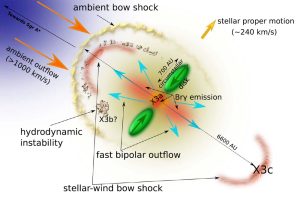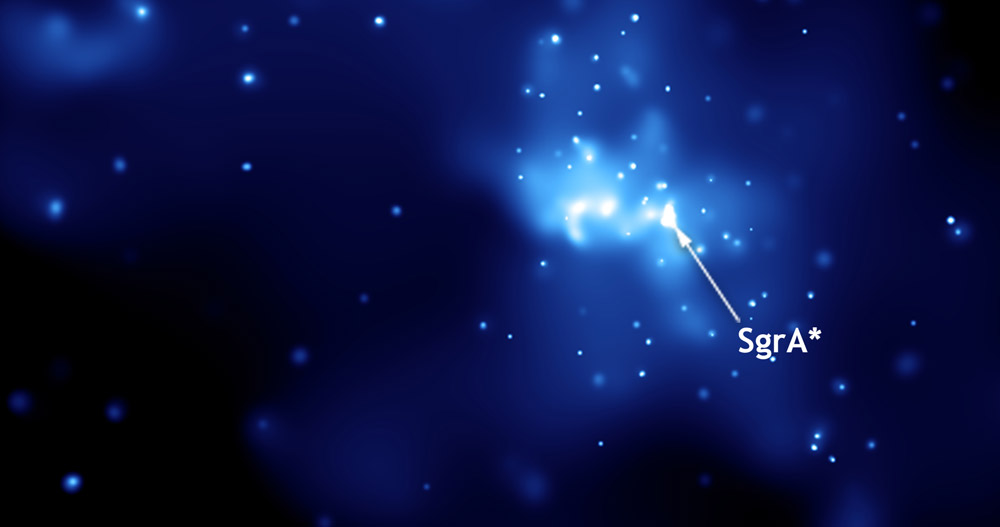A surprising discovery: For the first time, astronomers have detected a protostar growing directly in the Milky Way’s black hole — even though star formation there is actually considered impossible. Because the enormous tidal forces and radiation should prevent this. But the X3a star, which is only 10 thousand years old, now refutes this assumption. It is still growing, surrounded by a cocoon of dust and gas, the researchers report. How they can be so close to Sagittarius A* is baffling.
Not only does the supermassive black hole at the center of the Milky Way affect our galaxy as a whole, but its immediate surroundings are also shaped by the intense gravity and energetic emission of Sagittarius A*. Their gravity makes nearby stars some of the fastest in the entire Milky Way, causing them to exhibit relativistic phenomena such as the gravitational shifting of their light or Schwarzschild motion—the rose-like shift in their orbits.
Mysterious clumps at the black hole
Because of these extreme conditions, the conventional wisdom says that star formation cannot occur near a supermassive black hole. Because the huge tidal forces and strong radiation prevent the formation of the necessary cold and dense clouds of gas. The stars orbiting near Sagittarius A* today must have formed elsewhere – at least that’s what was thought.
However, in recent years astronomers have discovered some notable clusters of gas and younger stars around Sagittarius A* that have cast doubt on this assumption. So astronomers led by Florian Pesker of the University of Cologne closely examined some of these objects in the center of the Milky Way using several telescopes and high-resolution spectrometers. One of them is X3, a group of three hot clumps of blurred composition about a third of a light-year from the black hole.
Protostar in a dusty cocoon
The observations revealed something surprising: a young, immature star was hiding in one of the X3 clusters. Astronomers said: “It is a young stellar body surrounded by a disk embedded in a cocoon of dust in the form of an arcing wave.” The young star lying in the center of this system is about 15 times heavier than our Sun and is only a few thousand years old.
According to spectral analysis, this object called X3a is the so-called Herbig Ae/Be star. These protostars are not dense and heavy enough to ignite hydrogen fusion and derive their energy from colliding large amounts of matter. “The X3a star is still surrounded by a stellar disk with a radius of 700 AU,” Becker and his colleagues said. Multiple shock waves also appear as emissions from the nearby black hole collide with the outer shell of the stellar cocoon.
A young stellar giant contradicts the theory
But this means: Although X3a is not even a light year from the black hole, the young star was apparently able to defy all turbulence and tidal forces. It pretty much managed to capture its circumferential disk and dust cocoon. Astronomers attribute this to the young star’s large mass: “X3a’s large mass shields the inner region of the system, even though we have located the gravitational trace of Sagittarius A* only 0.32 light-years away,” say the astronomers.

The young giant star X3a thus contradicts previous assumptions about the “sterile” environment of supermassive black holes. Because even if the young star now has enough mass not to be torn apart again immediately, the question remains how it managed to form so close to the black hole. So far, astronomers can only speculate on the answer.
How and where did the X3a come about?
One possible explanation is that a cold molecular cloud of gas burrowed into the galactic center, providing the raw materials for star formation. “But there must have been at least a few traces of an intrusion of such a gas cloud a short time ago, such as long tails of gas and dust or trapped stars,” the team explains. But so far there are no clear signs of this. However, it is conceivable that X3a formed in a cloud orbiting a little farther from the black hole.
“Only a few light-years away from the black hole is a region that meets the conditions for star formation,” Baker explains. “This ring of gas and dust is cool enough and shielded from harmful rays.” “This so-called fall time roughly corresponds to the life of the X3a,” says Peißker. Only after initial star formation can interactions between gas clouds bring X3a and its cocoon closer to the black hole.
Astronomers now want to use more observations with the James Webb Space Telescope and other powerful telescopes to see if this scenario is plausible and if there are indications for it. (The Astrophysical Journal, 2023; doi: 10.3847/1538-4357/aca977)
Source: Astrophysical Journal, University of Cologne

“Total coffee aficionado. Travel buff. Music ninja. Bacon nerd. Beeraholic.”







More Stories
Everything related to prevention and treatment
The European Space Agency announces “signs of spiders on Mars”
Raising diamonds made easy – Spectrum Science